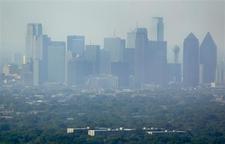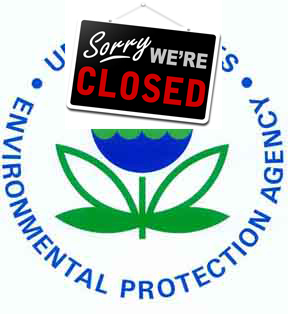car pollution
DFW Posted the Highest March Ozone Pollution on Record Saturday
 Beginning at noon on Saturday and continuing until 7pm, the air monitor in Frisco recorded a 75 parts per billion or higher level of ozone, a violation of the new smog standard just adopted by EPA. By evening it had come within less than 1 part per billion of violating the obsolete 85 ppb standard. It was the single highest ozone reading on a day in March since air monitoring for the pollutant began in DFW in the late 1990’s. A violation of the 85 ppb standard this early in the year would also have been an historic first because according to the government, “ozone season” doesn’t even officially start until April 1. What made it even more spectacular was that it was on a Saturday – traditionally not a high-ozone day of the week in DFW. Not an auspicious start to a year when we’re supposed to have the very lowest levels of ozone ever monitored, according to your Texas Commission on Environmental Quality. At least that’s what they told the EPA when they had to submit a plan for cleaning-up DFW ozone way back in December. It’s the miraculous new “free market new car pollution control measure” TCEQ has been touting for two years now that says so many more local residents will buy newer, cleaner cars that the air will reach almost Alpine purity by September. Unfortunately for Austin, all it took was some unseasonably warm weather in March (just an anomaly we’re sure) to consign that prediction to the ash heap of previous TCEQ predictions about improving air quality in DFW. To achieve TCEQ’s prediction for better 2012 ozone levels, Frisco’s air monitor can’t record anything higher than a 58 ppb 8-hour average this year. Yesterday, it was at 84.24 at the end of the worst eight hours that saw readings go as high as 96 ppb. Given the weather forecast for the rest of the week, it’s not unthinkable that we’ll have our first violation of that old 85 standard before April begins. We would say we told you so, but really, how smart do you have to be to know that another TCEQ optimistic prediction about DFW air quality would fail miserably right out of the gate?
Beginning at noon on Saturday and continuing until 7pm, the air monitor in Frisco recorded a 75 parts per billion or higher level of ozone, a violation of the new smog standard just adopted by EPA. By evening it had come within less than 1 part per billion of violating the obsolete 85 ppb standard. It was the single highest ozone reading on a day in March since air monitoring for the pollutant began in DFW in the late 1990’s. A violation of the 85 ppb standard this early in the year would also have been an historic first because according to the government, “ozone season” doesn’t even officially start until April 1. What made it even more spectacular was that it was on a Saturday – traditionally not a high-ozone day of the week in DFW. Not an auspicious start to a year when we’re supposed to have the very lowest levels of ozone ever monitored, according to your Texas Commission on Environmental Quality. At least that’s what they told the EPA when they had to submit a plan for cleaning-up DFW ozone way back in December. It’s the miraculous new “free market new car pollution control measure” TCEQ has been touting for two years now that says so many more local residents will buy newer, cleaner cars that the air will reach almost Alpine purity by September. Unfortunately for Austin, all it took was some unseasonably warm weather in March (just an anomaly we’re sure) to consign that prediction to the ash heap of previous TCEQ predictions about improving air quality in DFW. To achieve TCEQ’s prediction for better 2012 ozone levels, Frisco’s air monitor can’t record anything higher than a 58 ppb 8-hour average this year. Yesterday, it was at 84.24 at the end of the worst eight hours that saw readings go as high as 96 ppb. Given the weather forecast for the rest of the week, it’s not unthinkable that we’ll have our first violation of that old 85 standard before April begins. We would say we told you so, but really, how smart do you have to be to know that another TCEQ optimistic prediction about DFW air quality would fail miserably right out of the gate?
Closed Until The 2nd Tuesday in November
 There are at least four major EPA rules in line to be finalized in 2012 but don’t look for that to happen until after the elections. That’s the consensus of opinion from this Politico article, which says new regulations for lower sulfur gasoline, coal ash disposal, Greenhouse Gas limits on power plants and refineries and a new federal particulate matter standards are all on hold while the Obama Administration becomes full engaged in the 2012 Presidential campaign. ““If there’s one thing we’ve learned in a presidential election year, Democrats and Republicans behave similarly in that they are loath to propose or finalize a rule that could be construed as being controversial or having a significant impact on the economy,” said Bill Becker, executive director of the National Association of Clean Air Agencies, which represents state regulators. While some groups will be filing lawsuits, it’s not clear if the glacial pace of such efforts will be any quicker in getting the new rules than waiting until after the election.
There are at least four major EPA rules in line to be finalized in 2012 but don’t look for that to happen until after the elections. That’s the consensus of opinion from this Politico article, which says new regulations for lower sulfur gasoline, coal ash disposal, Greenhouse Gas limits on power plants and refineries and a new federal particulate matter standards are all on hold while the Obama Administration becomes full engaged in the 2012 Presidential campaign. ““If there’s one thing we’ve learned in a presidential election year, Democrats and Republicans behave similarly in that they are loath to propose or finalize a rule that could be construed as being controversial or having a significant impact on the economy,” said Bill Becker, executive director of the National Association of Clean Air Agencies, which represents state regulators. While some groups will be filing lawsuits, it’s not clear if the glacial pace of such efforts will be any quicker in getting the new rules than waiting until after the election.
If I can just get off of this LA Freeway, (with out getting sick or dying)
A radical notion, no? That thousands of concentrated small horizontal smokestacks emitting the leftovers of burning petroleum based products could cause breathing problems for people who live next to these areas of concentration, otherwise known as highways. It may strike you as common sense, but that common sense had no scientific foundation until fairly recently. In the last ten years, there’s been a remarkable wave of research connecting a variety of ailments to proximity to freeway pollution, including asthma, lung disease, bronchitis, emphysema, heart attacks, strokes, diabetes, and autism. So how should urban planners respond in routing traffic through a city when they know the people living near the traffic will statistically be at higher health risk? That’s the question starting to be debated in Los Angeles thanks to citizens and groups like the Natural Resources Defense Council. They’ve sued the local air quality district to make authorities locate monitors near or beside the most congested freeways in LA because they believe such monitors would show new violations of the Clean Air Act that could then be addressed. They’re also challenging city planners to take a new look at how roads are run through communities. For decades it was standard practice to slice up minority communities with freeways. Now, it seems likely there are Environmental Justice lawsuits that could be filed based on the same MO. This local fight has the potential to set a national precedent that could begin to affect many different proposed highway projects. Read this story and take note because the science is already here – the policy has to catch-up.
Inventorying the “most ambitious clean air rules in decades”
Reuters has the run down on the plethora of new EPA clean air rules coming down in the next year or so, including resolution of the cross-state regs, vehicle efficiency, fracking emissions, Greenhouse Gases, and Coal Ash rules. We know there’s been a lot of justifiable disappointment with this Administration, but please look at this agenda and try to imagine that any part of it would be coming from an EPA run by any of the current GOP presidential candidates. It’s pretty much impossible
FW Weekly Reviews the State of DFW Air
With the Star-Telegram abandoning the idea of having an environmental reporter all together, and the de facto abandonment of environmental beat coverage at the Dallas Morning News, DFW residents are having to rely on the alternative weeklies to provide the kind of coverage they used to get in the dailies. This week, the Ft. Worth Weekly provides another example of this trend with an excellent retrospective of where DFW air quality stands after the worst ozone season since 2007. Kudos to Weekly editor Gayle Reaves for taking up the slack and committing journalism in the name of public interest.
Better late than never: Texas Monthly does the Perry vs EPA story
TM’s Nate Blakeslee gets the assignment to track down how Rick Perry runs against those crazy environmentalists and EPA the way George Wallace ran against those crazy civil rights marchers and the Justice Department. He can’t quite bring himself to mention Downwinders’ name when establishing Region 6 EPA Administrator Al Armendariz’ credentials but we’re represented nonetheless as, “a citizens’ group that won a judgment against one of the many cement manufacturing companies south of Dallas, which have long contributed to the Metroplex’s intractable air pollution problems.” Nothing much new here, especially for those of us living this story, but it’s good to see Perry’s disastrous run for the Presidency have some decent side-effects like coverage of his anti-environmental stances.
UK Report: 200,000 Deaths Every Year from Dirty Air
A new study by members of the British Parliament who are organized into something called the Environmental Audit Committee concludes that 200,000 UK citizens die every year from breathing dirty air, which not only causes illness on its own, but exacerbates existing conditions. “Lewis Merdler, campaign manager at Environmental Protection UK, which leads the national Healthy Air Campaign, says air pollution in the UK has a huge impact on the nation’s respiratory and cardiovascular health, and particularly affects children and the elderly. ‘Air pollution in the UK represents a huge public health crisis, contributing to more premature deaths than obesity and passive smoking combined,’ he says. ‘It’s a scandal the Government isn’t doing more to protect the most vulnerable in our communities from dangerous levels of air pollution.”
Traffic Jams Your Lungs and Brain
Here’a a good summary piece in the Wall Street Journal (sub required, but this link seems to get you past that) about the large number of studies going on attempting to understand how traffic jam pollution affects human health. So far, researchers have shown connections to not only the obvious respiratory illnesses cause by breathing in bad stuff, but also to behavioral development, IQ, autism, and depression. “The evidence is growing that air pollution can affect the brain,” says medical epidemiologist Heather Volk at USC’s Keck School of Medicine. ‘We may be starting to realize the effects are broader than we realized.” So true for a countless number of pollutants these days. Which is why it’s always better to prevent their creation and release in the first place.
